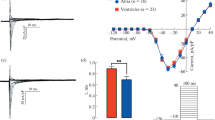Abstract
Cells in the pacemaker region of toad (Bufo marinus) sinus venosus had spontaneous rhythmic action potentials. The rate of firing of action potentials, the rate of diastolic depolarization and the maximum rate of rise of action potentials were reduced by TTX (10 nm to 1 μm). Currents were recorded with the whole cell, tight seal technique from cells enzymatically dissociated from this region. Cells studied were identified as pacemaker cells by their characteristic morphology, spontaneous rhythmic action potential activity that could be blocked by cobalt but not by TTX and lack of inward rectification. When calcium, potassium and nonselective cation currents (If) activated by hyperpolarization were blocked, depolarization was seen to generate transient and persistent inward currents. Both were sodium currents: they were abolished by tetrodotoxin (10 to 100 nm), their reversal potential was close to the sodium equilibrium potential and their amplitude and reversal potential were influenced as expected for sodium currents when extracellular sodium ions were replaced with choline ions. The transient sodium current was activated at potentials more positive than −40 mV while the persistent sodium current was obvious at more negative potentials. It was concluded that, in toad pacemaker cells, TTX-sensitive sodium currents contributing both to the upstroke of action potentials and to diastolic depolarization may play an important role in setting heart rate.
Similar content being viewed by others
References
Abraham, S., Beatch, G.N., MacLeod, B.A., Walker, M.J.A. 1989. Antiarrhythmic properties of tetrodotoxin against occlusioninduced arrhythmias in the rat: a novel approach to the study of the antiarrythmic effects of ventricular sodium channel blockade. J. Pharmacol Exp. Ther. 251:1161–1173
Attwell, D., Cohen, L, Eisner, D., Ohba, M., Ojeda, C. 1979. The steady state TTX-sensitive (“window”) sodium current in cardiac purkinje fibres. Pfluegers Arch. 379:137–142
Bramich, N.J., Edwards, F.R., Hirst, G.D.S. 1990. Sympathetic nerve stimulation and applied transmitters on the sinus venosus of the toad. J. Physiol. 429:349–375
Brown, A.M., Lee, K.S., Powell, T. 1981. Voltage clamp and internal perfusion of single rat heart muscle cells. J. Physiol. 318:455–477
Brown, A. M., Lee, K.S., Powell, T. 1981. Sodium current in single rat heart muscle cells. J. Physiol. 318:479–500
Brown, H.F., Kimura, J., Noble, D., Noble, S.J., Taupignon, A. 1984. The slow inward current, isi, in the rabbit sino-atrial node investigated by voltage clamp and computer simulation. Proc. R. Soc. London B 222:305–328
Bywater, R.A.R., Campbell, G., Edwards, F.R., Hirst, G.D.S., O'Shea, J.E. 1989. The effects of vagal stimulation and applied acetylcholine on the sinus venosus of the toad. J. Physiol. 415:35–56
Campbell, D.L., Rasmusson, R.L., Strauss, H.C. 1992. Ionic current mechanisms generating vertebrate primary cardiac pacemaker activity at the single cell level: an integrative view. Annu. Rev. Physiol. 54:279–302
Cohen, C.J., Bean, B.P., Colatsky, T.J., Tsien, R.W. 1981. Tetrodotoxin block of sodium channels in rabbit Purkinje fibers. Interactions between toxin binding and channel gating. J. Gen. Physiol. 78:383–411
Denyer, J.C., Brown, H.F. 1990. Rabbit sino-atral node cells: isolation and electrophysiological properties. J. Physiol. 428:405–424
DiFrancesco, D. 1985. The cardiac hyperpolarizing-activated current, If. Origins and developments. Prog. Biophys. Mol. Biol. 46:163–193
Edwards, F.R., Bramich, N.J., Hirst, G.D.S. 1993. Analysis of the effects of vagal stimulation on the sinus venosus of the toad. Phil. Trans. Roy. Soc. 341:149–162
Fozzard, H.A., January, C.T., Makielski, J.C. 1985. New studies of the excitatory sodium currents in heart muscle. Circ. Res. 56:475–485
Giles, W.R. (1989). In: Textbook of Physiology, H.D. Patton, A.F. Fuchs, B. Hille, A.M. Scher, and R. Steiner, editors. W.B. Saunders
Giles, W.R., Shibata, E.F. 1985. Voltage clamp of bull-frog cardiac pacemaker cells: A quantitative analysis of potassium currents. J. Physiol. 368:265–292
Hagiwara, N., Irisawa, H., Kasanuki, H., Hosoda, S. 1992. Background current in sino-atrial node cells of the rabbit heart. J. Physiol. 448:53–72
Hamill, O.P., Marty, A., Neher, E., Sakmann, B., Sigworth, F.J. 1981. Improved patch-clamp techniques for high resolution current recording from cells and cell-free membrane patches. Pfluegers Arch. 391:85–100
Horn, R., Marty, A. 1988. Muscarinic activation of ionic currents measured by a new whole-cell recording method. J. Gen. Physiol. 92:145–159
Hume, J.R., Giles, W. 1983. Ionic currents in single isolated bullfrog atrial cells. J. Gen. Physiol. 81:153–194
Irisawa, H., Brown, H.F., Giles, W. 1993. Cardiac pacemaking in the sinoatrial node. Physiol. Rev. 73:197–227
Josephson, I.R., Brown, A.M. 1986. Inwardly rectifying singlechannel and whole cell K currents in rat ventricular myocytes. J. Membrane Biol. 94:19–35
Ju, Y.-K., Saint, D.A., Gage, P.W. 1992. Effects of lignocaine and quinidine on the persistent sodium current in rat ventricular myocytes. Br. J. Pharmacol. 107:311–316
Kreitner, D. 1975. Evidence for the existence of a rapid sodium channel in the membrane of rabbit sinoatrial cells. J. Mol. Cell Cardiol. 7:655–662
Kunze, D.L., Brown, A.M. 1989. Isolated Adult Cardiomyocytes. H.M. Piper, and G. Isenberg, editors. Vol 2, pp. 15–28, CRC, Boca Raton
Levitan, E.S., Kramer, R. 1990. Neuropeptide modulation of single calcium and potassium channels detected with a new patch clamp configuration. Nature 348:545–547
Mandel, G. 1992. Tissue-specific expression of the voltagesensitive sodium channel. J. Membrane Biol. 125:193–205
Noble, D., Tsien, R.W. 1986. The kinetics and rectifier properties of the slow potassium current in cardiac Purkinje fibers. J. Physiol. 195:185–214
Rogart, R. 1981. Sodium channels in nerve and muscle membrane. Annu. Rev. Physiol. 43:711–725
Saint, D.A., Ju, Y.-K., Gage, P.W. 1992. A persistent sodium current in rat ventricular myocytes. J. Physiol. 453:219–231
Yamagishi, S., Sano, T. 1966. Effect of tetrodotoxin on the pacemaker action potential of sinus node. Proc. Jap. Acad. 42:1194–1196
Zhou, Z., Lipsius, S.L. 1992. Properties of the pacemaker current (If) in latent pacemaker cells isolated from cat right atrium. J. Physiol. 453:503–523
Author information
Authors and Affiliations
Additional information
We thank the Australian National Heart Foundation for their support. D.A.S. is an NHMRC Senior Research Officer.
Rights and permissions
About this article
Cite this article
Ju, Y.K., Saint, D.A., Hirst, G.D.S. et al. Sodium currents in toad cardiac pacemaker cells. J. Membarin Biol. 145, 119–128 (1995). https://doi.org/10.1007/BF00237370
Received:
Revised:
Issue Date:
DOI: https://doi.org/10.1007/BF00237370




